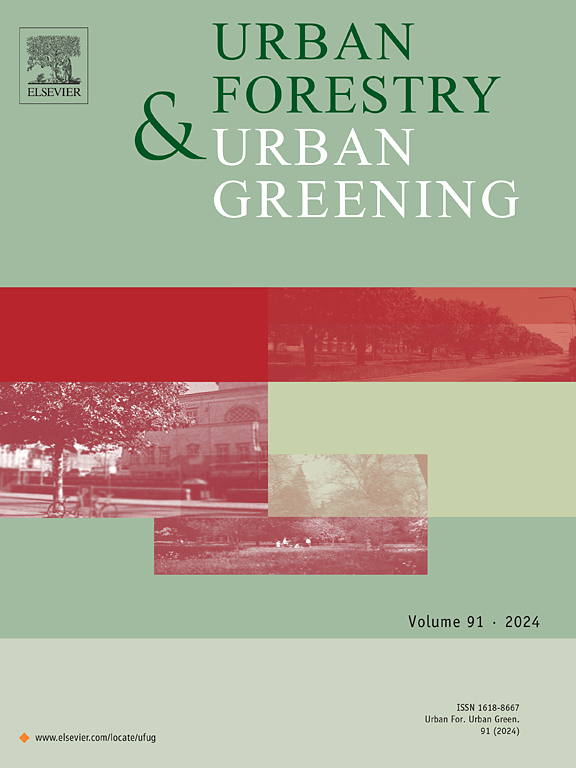城市学校的植被复杂性和绿地多样性
IF 6.7
2区 环境科学与生态学
Q1 ENVIRONMENTAL STUDIES
引用次数: 0
摘要
城市绿地对于保持生物多样性和人与自然的联系至关重要。学校分布在城市的各个角落,有可能提供并提高本地生物多样性,同时促进儿童与自然之间的积极关系。然而,人们对校园绿地,尤其是其生态状况知之甚少。我们对新西兰奥克兰市 64 所城市小学的绿地面积和质量进行了评估,通过快速绿地评估确定了校园绿地类型的相对比例、植被和栖息地质量。所有学校的校园内都有树木,但只有 36% 的学校有原生林地,而且由于运动场、人工草皮和灌木层的缺乏,栖息地质量普遍较低。校园中不同类型绿地的数量越多,大树(6 米)就越多,栖息地质量得分就越高。三分之一的学校还存在一种或多种环境杂草。学校的社会经济地位似乎并不是预测学校绿地质量的关键因素。有很多机会可以改善学校绿地,使其作为多功能空间更好地促进城市生物多样性。增加绿地类型的多样性、增加植被层数、增加校园本土植物物种的多样性,都将提高栖息地的复杂性,改善生物多样性和文化联系的成果。校园作为多功能空间的价值将取决于具体地方的生态和文化背景。本文章由计算机程序翻译,如有差异,请以英文原文为准。
Vegetation complexity and greenspace diversity in urban schools
Urban greenspaces are critical for maintaining biodiversity and people’s connection to nature. Schools are distributed throughout cities and have the potential to provide for and enhance native biodiversity, while facilitating positive relationships between children and nature. However, very little is known about greenspaces on school grounds, particularly their ecological condition. We evaluated the size and quality of greenspaces in 64 urban primary schools in Auckland, Aotearoa–New Zealand by undertaking a rapid greenspace assessment to identify the relative proportions of greenspace types on school grounds, vegetation and habitat quality. All schools had trees present on their grounds, however only 36 % had a native forest patch, and habitat quality was generally low due to the dominance of sports fields, artificial turf and a lack of shrub layer. A larger number of different greenspace types on school grounds was associated with more large trees (>6 m), and a higher habitat quality score. A third of schools also had one or more environmental weed species present. The socio-economic status of schools did not appear to be a key factor in predicting the quality of a school’s greenspace. There are many opportunities to improve school greenspaces to better contribute to urban biodiversity as multifunctional spaces. Increasing greenspace type diversity, adding more vegetation layers, and increasing the diversity of native plant species on school grounds, would increase habitat complexity and improve biodiversity and cultural connection outcomes. The value of school grounds as multifunctional spaces will depend on place-specific ecological and cultural contexts.
求助全文
通过发布文献求助,成功后即可免费获取论文全文。
去求助
来源期刊

Urban Forestry & Urban Greening
FORESTRY-
CiteScore
11.70
自引率
12.50%
发文量
289
审稿时长
70 days
期刊介绍:
Urban Forestry and Urban Greening is a refereed, international journal aimed at presenting high-quality research with urban and peri-urban woody and non-woody vegetation and its use, planning, design, establishment and management as its main topics. Urban Forestry and Urban Greening concentrates on all tree-dominated (as joint together in the urban forest) as well as other green resources in and around urban areas, such as woodlands, public and private urban parks and gardens, urban nature areas, street tree and square plantations, botanical gardens and cemeteries.
The journal welcomes basic and applied research papers, as well as review papers and short communications. Contributions should focus on one or more of the following aspects:
-Form and functions of urban forests and other vegetation, including aspects of urban ecology.
-Policy-making, planning and design related to urban forests and other vegetation.
-Selection and establishment of tree resources and other vegetation for urban environments.
-Management of urban forests and other vegetation.
Original contributions of a high academic standard are invited from a wide range of disciplines and fields, including forestry, biology, horticulture, arboriculture, landscape ecology, pathology, soil science, hydrology, landscape architecture, landscape planning, urban planning and design, economics, sociology, environmental psychology, public health, and education.
 求助内容:
求助内容: 应助结果提醒方式:
应助结果提醒方式:


